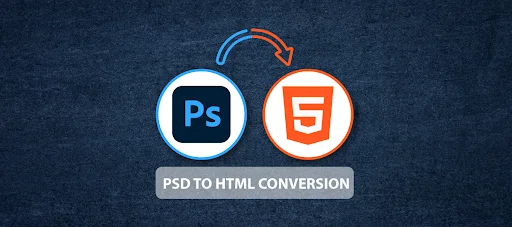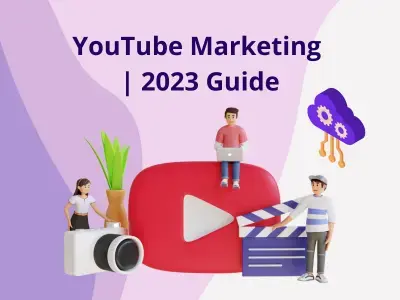Websites are the need of every business. In today’s website-focused online landscape, having a responsive, feature-rich, and visually appealing website is essential for any business to thrive. Among this ever-growing demand, one of the most popular methods for building a website with such metrics is proceeding with PSD to responsive HTML conversion.
This process involves transforming a static design file, such as a PSD, into a functional and interactive website using HTML, CSS, and other technologies.
While the focus is often on achieving a visually stunning website, it is equally important to optimize the HTML code and structure for search engine optimization (SEO). In this ultimate guide, we will explore the best practices and techniques to optimize your PSD to responsive HTML conversion for improved SEO performance.

1. Proper Site Structure
A well-structured website defines your business – like how serious you are about your business. It’ll also impact your SEO performance. When converting your PSD design to HTML, pay attention to the organization and hierarchy of your site. Consider the navigation, page hierarchy, and URL structure. This makes the crawling and indexation process easier for search engines. For optimal results, consider outsourcing this task to SEO digital agencies, as they specialize in optimizing website structure for improved search engine visibility.
2. Optimize Your Images
Images significantly impact your site’s speed and performance. When converting your PSD design files into a responsive HTML website, make sure you optimize your images. This means reducing your file sizes without compromising on the quality. Use descriptive alt tags and file names to give your images meaning and context for search engines.
3. Use Semantic HTML
Semantic HTML means using tags that add meaning and context to your website’s content. For instance, if your page is about digital marketing trends, make sure you add respective titles and heading tags to help search engines understand your content easily. This not only gives your content a well-optimized readability score but also helps search engines understand the content’s relevance and improve its search visibility for respective keywords.
4. Use Meta Tags
Meta tags are important, just as a good web design is. These tags help search engines understand your website’s content, improving your site’s visibility and online presence. These tags include relevant information such as the title, description, and keywords, to help search engines such as Google to understand your site’s purpose and the content of each page. Adding meta tags not only improves your website’s visibility but also boosts your search rankings.
5. Optimize Your Website’s Code
Clean and optimized code is essential for good SEO performance. When converting your PSD design to HTML, ensure your code is well-organized, efficient, and free of unnecessary elements. Avoid using difficult inline styles, extra elements, excessive divs, useless animations, and unnecessary JavaScript that slows your website and hurts your user experience.
6. Get Mobile-Friendly
As more and more people surf online on their mobile devices, having a mobile-responsive website has become a MUST for SEO success. When converting your designs, ensure your website is responsive to different browsers and screen sizes. By doing so, you’ll not only provide your users with a great website experience, but it’ll also help your website get higher rankings in search results.
7. Improve Your Site Speed
Site speed is a critical factor. If you want your users to have a good experience on your website and maintain a good SEO score, you have to achieve a good site loading score. When converting your PSD design files to responsive HTML, make sure you optimize your pages for maximum speed, minimizing file sizes, reducing HTTP requests, and utilizing browser caching. Keep testing your website’s speed for updates and necessary improvements. To ease your testing, use tools such as PageSpeed Insights or GTmetrix for faster and more accurate results.
8. Add Structured Data
Structured data is highly important for a well-developed website. It provides additional information to crawling bots about your website’s content and its context (i.e. blog, page, podcast, etc.). When converting your design files, consider adding structured data to your coding. This helps search engines understand your pages better and provide rich snippets in search results that will improve your click-through rates – leading to improved visibility and more traffic.
9. Create Quality Content
While not directly related to the PSD to responsive HTML conversion process, creating quality content is essential for SEO success. When designing your website’s PSD files, include relevant and informative content that will be optimized later for your business’s target keywords. This will further help your rankings to gain more organic traffic.
10. Monitor Your Analytics
Ensure you monitor your website’s performance in your analytics for better SEO progress. Use tools like Google Analytics to gain insights about your website’s search traffic, visibility, impressions, user behavior, conversion rates, and much more. By analyzing your user data, you can identify areas that need improvement and work on your website accordingly to adjust the SEO strategy for better results.
11. Optimize Your URLs
Your website’s URLs play a significant role when converting your PSD design to HTML. Optimize your URLs by using descriptive and keyword-rich slugs. Keep them concise, relevant, and separated by hyphens. Avoid using special characters or numbers that do not provide helpful information.
12. Use the HTML Tags
HTML tags are like building blocks required to set up a good structure for your website. Correctly using them will deliver you a robust website. Use heading tags to structure your page content and include relevant keywords to make it more contextual. Alt tags for images should also be descriptive and keyword-rich.
13. Use Responsive Design
In today’s mobile-centric approach, having a mobile-responsive website is highly important. When converting your PSD design files into responsive HTML, make sure your website remains responsive and adapts to different screen sizes, browsers, and devices. This will not only improve your user experience but will also help you rank your website higher in mobile search results. Partnering with a reputable web design agency in Dubai can streamline this process, ensuring that your website is not only visually appealing but also fully functional across all devices and platforms.
14. Build Backlinks.
Backlinks are important for SEO; we all know that. You should get backlinks from relevant and authoritative websites that have higher domain authority and page authority scores. So, you should check the authority of a website with a reliable DA PA checker before getting backlinks. Getting backlinks from relevant websites or expired SEO domains tells search engines that other websites find your website’s content relevant, high-quality, and valuable.
When converting your PSD design files, focus on creating high-quality content that other websites will want to mention and link to – making your website’s content stand out in the crowd. In addition to that, reach out to relevant websites in your niche and offer a backlink acquisition request to increase your website’s authority and rankings at the same time. Backlinks can also be obtained by niche edits technique.
Conclusion
By following these practices and techniques, you can optimize your PSD to a responsive HTML conversion process with improved SEO performance simultaneously. Remember that SEO is an ongoing process that requires continuous effort, time, and monitoring to maintain and improve your website’s visibility and search rankings.
So, rather than just doing it for once while conversion, make sure you manage some time to work on it and promote your website. Stay updated with the latest SEO trends, practices, and algorithm updates to ensure your website stays optimized, relevant, and up-to-date in your respective niche. We hope this article helps you optimize your website in your PSD to HTML conversion process.
- Best GPS Tracking Software With Source Code – Fleet Stack - July 24, 2024
- Best Shopify Unified Payment Mediation Platform | UnumPay Review - May 21, 2024
- 5 Best Shopify Payment Apps in 2024 - May 16, 2024


